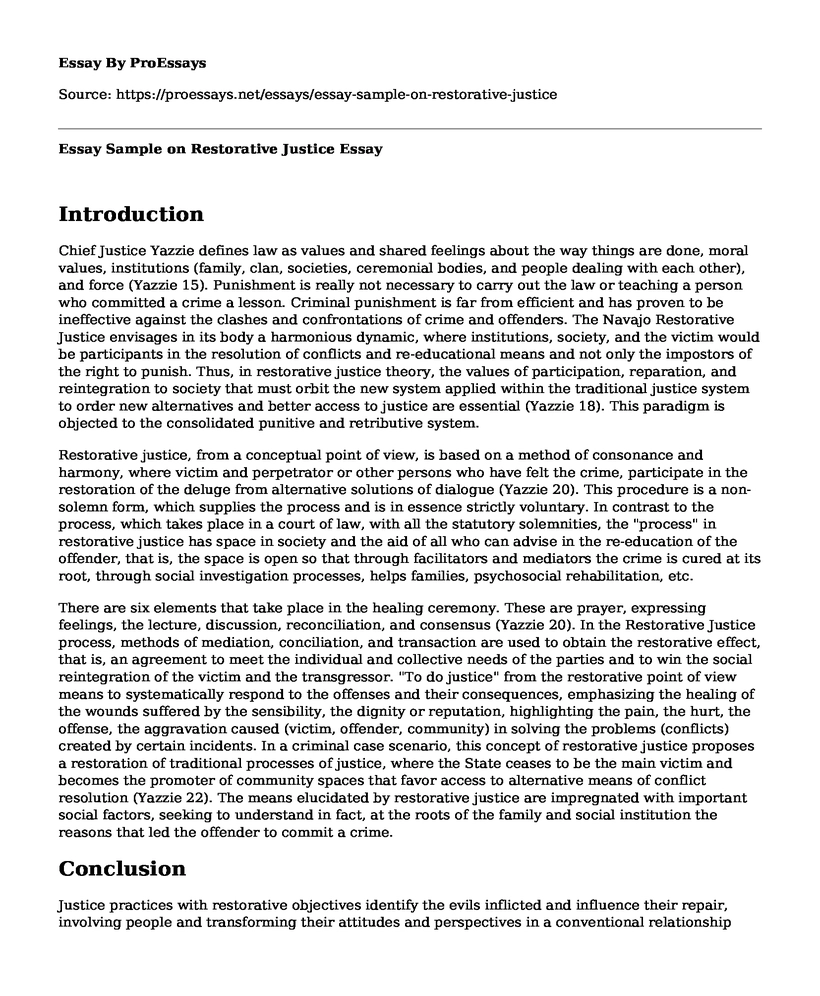Introduction
Chief Justice Yazzie defines law as values and shared feelings about the way things are done, moral values, institutions (family, clan, societies, ceremonial bodies, and people dealing with each other), and force (Yazzie 15). Punishment is really not necessary to carry out the law or teaching a person who committed a crime a lesson. Criminal punishment is far from efficient and has proven to be ineffective against the clashes and confrontations of crime and offenders. The Navajo Restorative Justice envisages in its body a harmonious dynamic, where institutions, society, and the victim would be participants in the resolution of conflicts and re-educational means and not only the impostors of the right to punish. Thus, in restorative justice theory, the values of participation, reparation, and reintegration to society that must orbit the new system applied within the traditional justice system to order new alternatives and better access to justice are essential (Yazzie 18). This paradigm is objected to the consolidated punitive and retributive system.
Restorative justice, from a conceptual point of view, is based on a method of consonance and harmony, where victim and perpetrator or other persons who have felt the crime, participate in the restoration of the deluge from alternative solutions of dialogue (Yazzie 20). This procedure is a non-solemn form, which supplies the process and is in essence strictly voluntary. In contrast to the process, which takes place in a court of law, with all the statutory solemnities, the "process" in restorative justice has space in society and the aid of all who can advise in the re-education of the offender, that is, the space is open so that through facilitators and mediators the crime is cured at its root, through social investigation processes, helps families, psychosocial rehabilitation, etc.
There are six elements that take place in the healing ceremony. These are prayer, expressing feelings, the lecture, discussion, reconciliation, and consensus (Yazzie 20). In the Restorative Justice process, methods of mediation, conciliation, and transaction are used to obtain the restorative effect, that is, an agreement to meet the individual and collective needs of the parties and to win the social reintegration of the victim and the transgressor. "To do justice" from the restorative point of view means to systematically respond to the offenses and their consequences, emphasizing the healing of the wounds suffered by the sensibility, the dignity or reputation, highlighting the pain, the hurt, the offense, the aggravation caused (victim, offender, community) in solving the problems (conflicts) created by certain incidents. In a criminal case scenario, this concept of restorative justice proposes a restoration of traditional processes of justice, where the State ceases to be the main victim and becomes the promoter of community spaces that favor access to alternative means of conflict resolution (Yazzie 22). The means elucidated by restorative justice are impregnated with important social factors, seeking to understand in fact, at the roots of the family and social institution the reasons that led the offender to commit a crime.
Conclusion
Justice practices with restorative objectives identify the evils inflicted and influence their repair, involving people and transforming their attitudes and perspectives in a conventional relationship with the justice system, meaning, therefore, to work to restore, reconstitute, reconstruct; so that all those involved and affected by a crime or infraction should, if they wish, have the opportunity to participate in the restorative process. The restorative model presents at its bases an ambitious plan of response to the crime. This model inaugurates a reflexive process, where its lights are reflected not only to the offender but also to the victim and to the whole society with the purpose of solving, through social pacification, the conflictive relationship that gave rise to the crime. With this in mind, all parties, who directly or indirectly felt touched by the criminal wave of that specific fact, can comprise an alternative of the socio-educational solution, proposing a positive action against the social reality of victim-offender solving the consequences of the fact. This innovative archetype of justice has been embodied in the use of measurement practices, that is, restorative justice proposes a peaceful confrontation between the parties involved. This confrontation brings incisive results, it is a corollary model, where the chances of the subject delinquent returning to crime would be reduced by educational and rehabilitation measures, allowing the personal maturity of the offender by means of measures that point to him the effects of crime to the victim and to the rumble of the criminal fact that erupted into law and society.
Works Cited
Yazzie, Robert. Healing as Justice: The Navajo Response to Crime. Living Justice Press, St. Paul, Minnesota, 2005, pp. 14-28.
Cite this page
Essay Sample on Restorative Justice. (2022, Aug 03). Retrieved from https://proessays.net/essays/essay-sample-on-restorative-justice
If you are the original author of this essay and no longer wish to have it published on the ProEssays website, please click below to request its removal:
- The Modern Biosocial Perspectives of Criminal Behavior Essay
- The Unlicensed Reproduction of Copyrighted Media Essay
- Freedom and Equality in Society Paper Example
- Essay Sample on John Marshall: Most Influential United States Supreme Court Justice in History
- Making Arguments on Gun Control Across Media
- Case Study on Marcus Dixon
- Essay Example on Digital Transformation: Ramping Up Change and Threats







